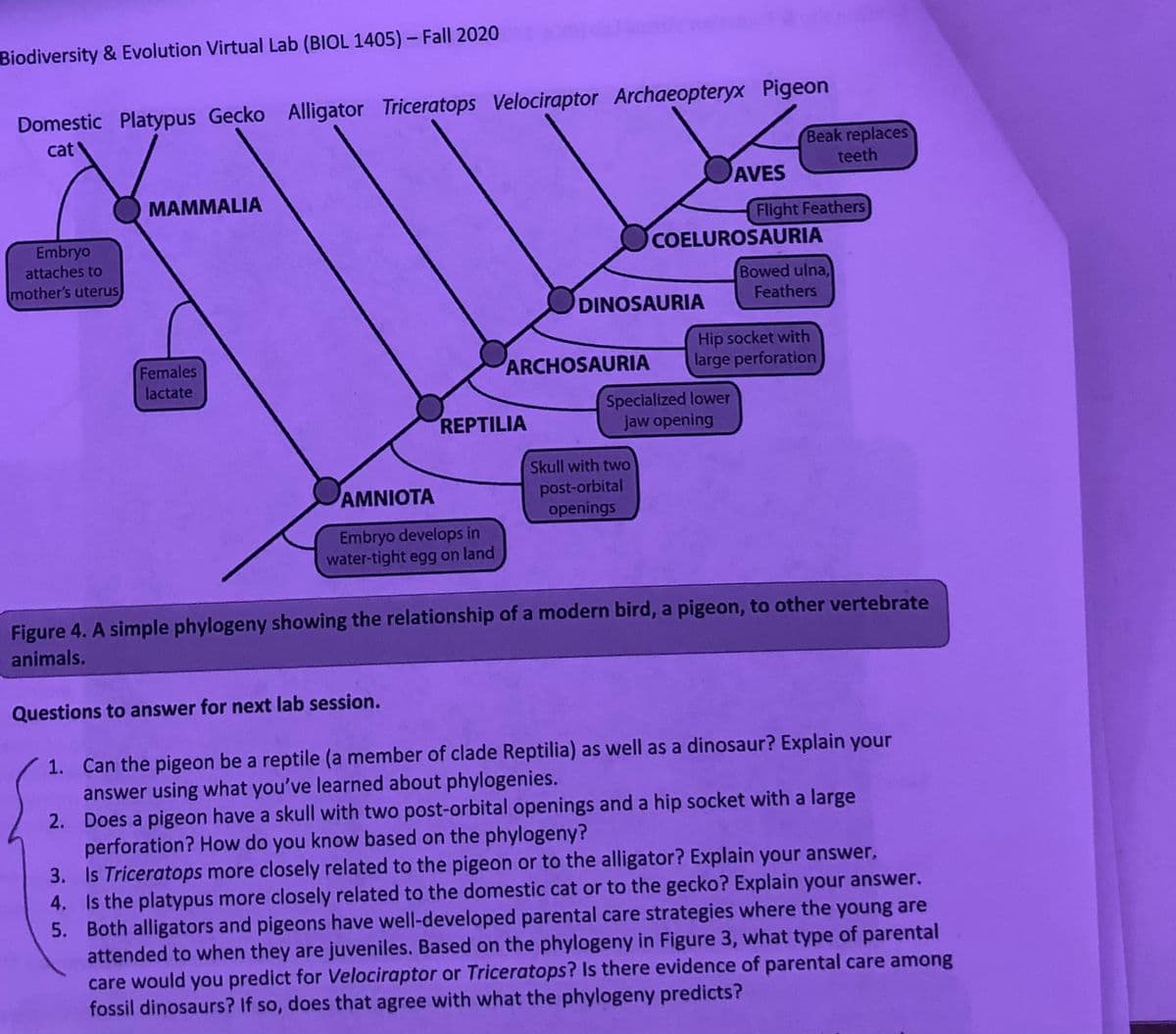Biodiversity & Evolution Virtual Lab (BIOL 1405)- Fall 2020 Domestic Platypus Gecko Alligator Triceratops Velociraptor Archaeopteryx Pigeon cat Beak replaces teeth AVES MAMMALIA Flight Feathers COELUROSAURIA Embryo attaches to mother's uterus Bowed ulna, Feathers DINOSAURIA Females lactate Hip socket with large perforation ARCHOSAURIA Specialized lower jaw opening REPTILIA Skull with two post-orbital openings AMNIOTA Embryo develops in water-tight egg on land Figure 4. A simple phylogeny showing the relationship of a modern bird, a pigeon, to other vertebrate animals. Questions to answer for next lab session. 1. Can the pigeon be a reptile (a member of clade Reptilia) as well as a dinosaur? Explain your answer using what you've learned about phylogenies. 2. Does a pigeon have a skull with two post-orbital openings and a hip socket with a large perforation? How do you know based on the phylogeny? 3. Is Triceratops more closely related to the pigeon or to the alligator? Explain your answer, 4. Is the platypus more closely related to the domestic cat or to the gecko? Explain your answer. 5. Both alligators and pigeons have well-developed parental care strategies where the young are attended to when they are juveniles. Based on the phylogeny in Figure 3, what type of parental care would you predict for Velociraptor or Triceratops? Is there evidence of parental care among fossil dinosaurs? If so, does that agree with what the phylogeny predicts?
Biodiversity & Evolution Virtual Lab (BIOL 1405)- Fall 2020 Domestic Platypus Gecko Alligator Triceratops Velociraptor Archaeopteryx Pigeon cat Beak replaces teeth AVES MAMMALIA Flight Feathers COELUROSAURIA Embryo attaches to mother's uterus Bowed ulna, Feathers DINOSAURIA Females lactate Hip socket with large perforation ARCHOSAURIA Specialized lower jaw opening REPTILIA Skull with two post-orbital openings AMNIOTA Embryo develops in water-tight egg on land Figure 4. A simple phylogeny showing the relationship of a modern bird, a pigeon, to other vertebrate animals. Questions to answer for next lab session. 1. Can the pigeon be a reptile (a member of clade Reptilia) as well as a dinosaur? Explain your answer using what you've learned about phylogenies. 2. Does a pigeon have a skull with two post-orbital openings and a hip socket with a large perforation? How do you know based on the phylogeny? 3. Is Triceratops more closely related to the pigeon or to the alligator? Explain your answer, 4. Is the platypus more closely related to the domestic cat or to the gecko? Explain your answer. 5. Both alligators and pigeons have well-developed parental care strategies where the young are attended to when they are juveniles. Based on the phylogeny in Figure 3, what type of parental care would you predict for Velociraptor or Triceratops? Is there evidence of parental care among fossil dinosaurs? If so, does that agree with what the phylogeny predicts?
Biology 2e
2nd Edition
ISBN:9781947172517
Author:Matthew Douglas, Jung Choi, Mary Ann Clark
Publisher:Matthew Douglas, Jung Choi, Mary Ann Clark
Chapter27: Introduction To Animal Diversity
Section: Chapter Questions
Problem 13RQ: Which of the following periods is the earliest during which animals may have appeared? Ordovician...
Related questions
Question
Please answer question 4

Transcribed Image Text:Biodiversity & Evolution Virtual Lab (BIOL 1405) – Fall 2020
Domestic Platypus Gecko Alligator Triceratops Velociraptor Archaeopteryx Pigeon
cat
Beak replaces
teeth
AVES
MAMMALIA
Embryo
attaches to
Flight Feathers
COELUROSAURIA
mother's uterus
Bowed ulna,
Feathers
DINOSAURIA
Females
lactate
Hip socket with
large perforation
ARCHOSAURIA
Specialized lower
jaw opening
REPTILIA
Skull with two
AMNIOTA
post-orbital
openings
Embryo develops in
water-tight egg on land
Figure 4. A simple phylogeny showing the relationship of a modern bird, a pigeon, to other vertebrate
animals.
Questions to answer for next lab session.
1. Can the pigeon be a reptile (a member of clade Reptilia) as well as a dinosaur? Explain your
answer using what you've learned about phylogenies.
2. Does a pigeon have a skull with two post-orbital openings and a hip socket with a large
perforation? How do you know based on the phylogeny?
3. Is Triceratops more closely related to the pigeon or to the alligator? Explain your answer,
4. Is the platypus more closely related to the domestic cat or to the gecko? Explain your answer.
5. Both alligators and pigeons have well-developed parental care strategies where the young are
attended to when they are juveniles. Based on the phylogeny in Figure 3, what type of parental
care would you predict for Velociraptor or Triceratops? Is there evidence of parental care among
fossil dinosaurs? If so, does that agree with what the phylogeny predicts?
Expert Solution
This question has been solved!
Explore an expertly crafted, step-by-step solution for a thorough understanding of key concepts.
This is a popular solution!
Trending now
This is a popular solution!
Step by step
Solved in 2 steps

Knowledge Booster
Learn more about
Need a deep-dive on the concept behind this application? Look no further. Learn more about this topic, biology and related others by exploring similar questions and additional content below.Recommended textbooks for you

Biology 2e
Biology
ISBN:
9781947172517
Author:
Matthew Douglas, Jung Choi, Mary Ann Clark
Publisher:
OpenStax

Biology: The Unity and Diversity of Life (MindTap…
Biology
ISBN:
9781337408332
Author:
Cecie Starr, Ralph Taggart, Christine Evers, Lisa Starr
Publisher:
Cengage Learning

Biology 2e
Biology
ISBN:
9781947172517
Author:
Matthew Douglas, Jung Choi, Mary Ann Clark
Publisher:
OpenStax

Biology: The Unity and Diversity of Life (MindTap…
Biology
ISBN:
9781337408332
Author:
Cecie Starr, Ralph Taggart, Christine Evers, Lisa Starr
Publisher:
Cengage Learning